
One of Vienna’s oldest areas witnessed one of its darkest periods: the persecution, murder and expulsion of the Jews that made their home in and around Judenplatz in the early 1400s.
Today, the pedestrianised square retains a historical look, with every building at least 120 years old and some still shored up by medieval stone and timber.
- Take a guided walking tour* around WWII sites & memorials
- See also:
- Am Hof square
- Jewish Vienna
The history and buildings
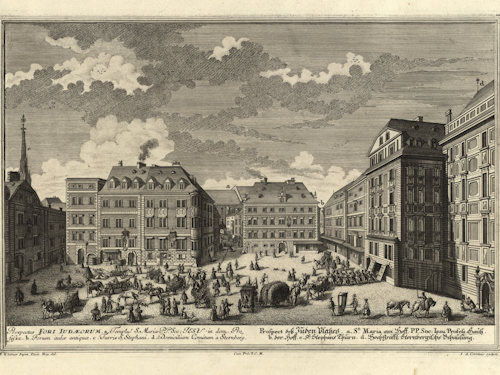
(View of Judenplatz from 1725 looking across to the southwest; illustrated by Salomon Kleiner, engraved by Johann August Corvinus, and published by Johann Andreas d. Ä. Pfeffel; Wien Museum Inv.-Nr. 105765/50; excerpt reproduced with permission under the terms of the CC0 licence)
The area around Judenplatz once echoed to the sounds of a Roman encampment and later formed the core of the medieval Jewish community.
The defining dates in the square’s history came in 1420/1421 with the Vienna Gesera: the persecution, then expulsion or murder of the city’s Jews (sadly, not the last time this would happen).

(Judenplatz in 2021)
To learn more about that early history, drop into the Jewish museum at Judenplatz 8, which also leads you down and through to the remains of a medieval synagogue unearthed under the square.
Many of today’s buildings still sit on medieval foundations or may even include medieval elements within their walls.
But what exactly can you see on Judenplatz in modern-day Vienna? We begin with the two monuments…
Holocaust and Lessing memorials
The square’s association with the Gesera adds a deeper resonance to the two monuments on the square.
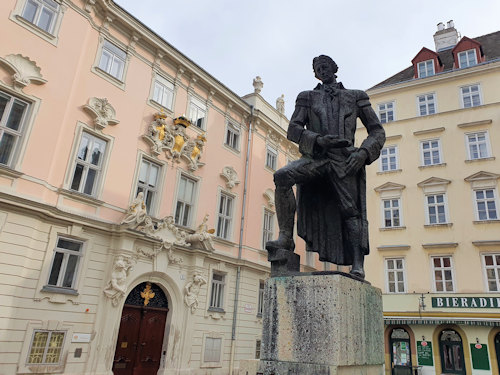
(The Lessing memorial)
One commemorates Gotthold Ephraim Lessing (1729-1781), a leading writer of the Enlightenment in Germany and thus a voice for peace, tolerance and reason.
The first statue went up here in 1935, but, with a sad inevitability, the Nazis destroyed it a few years later.
A “second “replacement” statue from the same sculptor (Siegfried Charoux) eventually appeared in Vienna in 1968 and moved to the Judenplatz in 1981.
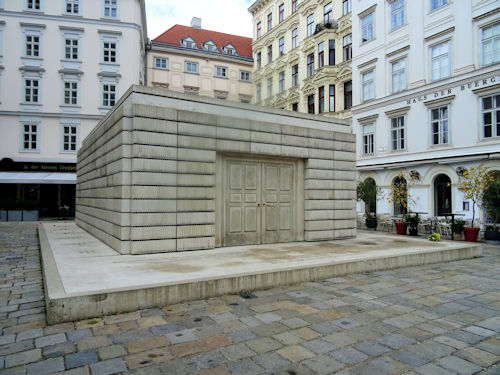
(An inverted library of stone)
Rachel Whiteread’s Holocaust memorial bears the names of those iniquitous concentration camps where the Nazis murdered thousands of Austrian Jews. The city unveiled the memorial in 2000.
In another twist of historical fate, the building works led to the rediscovery of the synagogue beneath the square and to renewed interest in the medieval (Jewish) history of the area.
Zur Flucht nach Ägypten (No.1)
The house at Judenplatz 1 is early 19th century and carries the name, Zur Flucht nach Ägypten (The Flight into Egypt).
The location enjoys a particular literary connection. Franz Grillparzer, the famous Austrian writer and playwright, apparently lived in the building that preceded today’s house.
Grillparzer (1791-1872) remains one of Austria’s greatest exponents of the written word. He crafted the eulogy at Beethoven’s funeral and lived in the same house as the composer in 1808. A large monument to him sits at one end of the Volksgarten.
You can even visit Grillparzer’s old office inside the Literature Museum and find a reconstruction of his living room (with the original furniture) at the Wien Museum‘s main location.
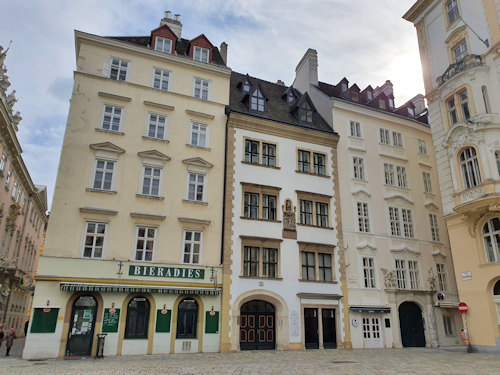
(The Zur Flucht nach Ägypten on the left and Zum großen Jordan in the middle)
Zum großen Jordan (No.2)
The narrow house at Judenplatz 2 looks old and for good reason. Significant parts date back to the mid-16th century and earlier. The relief that dominates the front is perhaps 15th century and has Saint George above a scene of Jesus’s baptism.
The Latin inscription beneath the relief refers approvingly to the events of the Gesera and uses astonishingly anti-semitic language. It presumably remains because of its historical value, but the ugly sentiments add to the poignancy of the square given the location’s past.
Judenplatz 3-4, 5 and 6
All three buildings at numbers 3-4, 5, and 6 are relatively new additions to the Judenplatz landscape; they date back to around the turn of the 20th century.
House 3-4 used to be two separate buildings until the innkeeper’s cooperative came into possession of both, knocked them down, and had a single building put up in their place around 1895.
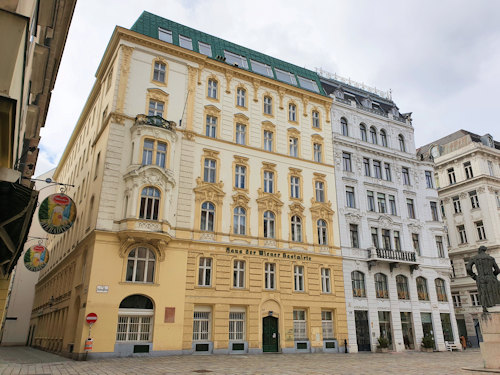
(No.3-4: yellow house on the left; No.5: house on the right)
The previous house at No.3 had a rather famous occupant in one of its apartments: Mozart. Most of his residences in Vienna no longer exist, with a notable exception: the Mozartwohnung.
The cooperative put up a plaque outside in 1929 to mark the historical musical connection. This is what it says (my translation):
House No.244, in which Mozart lived in 1783, once stood at this location.
Zur kleinen Dreifaltigkeit (No.7)
What you can see today at Judenplatz 7 is largely the result of late 18th-century and early 19th-century construction work, lovingly restored in recent years by the European Heritage Project.
However, the Zur kleinen Dreifaltigkeit house (which roughly translates as “The small Trinity house”) still retains medieval elements in, for example, its basement.
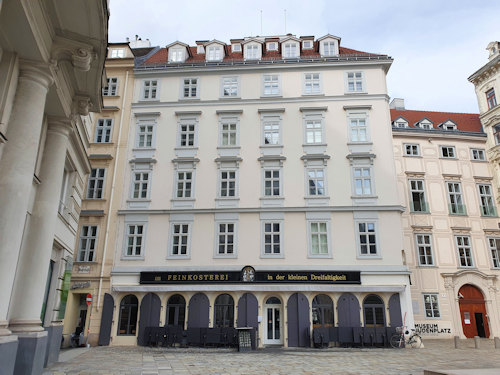
(Judenplatz No.7: the Zur kleinen Dreifaltigkeit house)
I believe the name comes from the small statue representing the Holy Trinity at the corner of the house (the front right corner as you look at the building from the square); a Trinitas chapel once formed part of the complex.
The Die Feinkosterei restaurant occupying the ground floor rather delightfully applies the Spanish tapas approach to Austrian cuisine.
Misrachihaus (No.8)

(Always worth a visit for the special exhibitions inside)
As mentioned earlier, house number 8 on Judenplatz notably provides a home for one part of the Jewish Museum.
The location serves as a venue for special exhibitions but also features that permanent exhibition on the medieval Jewish community mentioned earlier.
Remarkably, the building dates back to at least the 13th century, though most of what you now see resulted from various phases of redevelopment through the centuries. The façade is Baroque, for example.
The house had various Jewish owners until that first sweeping murderous expulsion of the Jewish community from Vienna. It would be over 400 years before the property returned to Jewish hands.
Judenplatz 9 and 10

(No. 10 with No.9 on the left)
The next two houses are both 19th-century town houses: No.9 from the late 1800s, No. 10 from the Biedermeier era. The buildings sit on the former site of the medieval Jewish school and hospital.
The title Haus der buergerl. Schneider on the wall of No.10 refers to the site’s long historical connection to the tailors guild (Schneider is German for tailor).
Former Böhmische Hofkanzlei (No.11)
The large palais-like building that completes our tour of Judenplatz stands out for its size and purpose. It houses Austria’s Supreme Administrative Court (Verwaltungsgerichtshof), which is one of a triumvirate of supreme courts (the others are the Constitutional Court and the Supreme Court of Justice).

(The rear of the Böhmische Hofkanzlei)
None other than Johann Bernhard Fischer von Erlach designed the building, which dates back to the early 18th century with a further expansion in the 1750s.
Fischer von Erlach’s eye for architecture lies behind many Viennese landmarks, including the Karlskirche, the Spanish Riding School, the State Hall of the National Library, and Schönbrunn Palace. The side facing Judenplatz is actually the rear of the building.
That new construction provided a home for the Böhmische Hofkanzlei (Bohemian Court Chancery), which we can think of as the administrative centre responsible for Bohemia (the Habsburgs also ruled the lands covered by the Bohemian crown).
Thus began a long association between the building and various state offices that continues today.
And that, as they say, is that.